I’ve already let you in on my Top 10 John Wayne Westerns so I thought it worth revisiting the reviews I wrote on JWs excursions into the war film genre a few years back but this time placing them in order of preference.
A list of my top 10 John Wayne best war movies starting with number…
10. The Flying Leathernecks (1951)
Based on watching this movie, I’d say Sergeant Stryker miraculously recovered from being shot in the back on Iwo Jima, changed his name to Daniel Kirby, somehow managed to get himself in command of a Marine Fighter Squadron, then adopted the rank of Major which I guess obviously paid more.
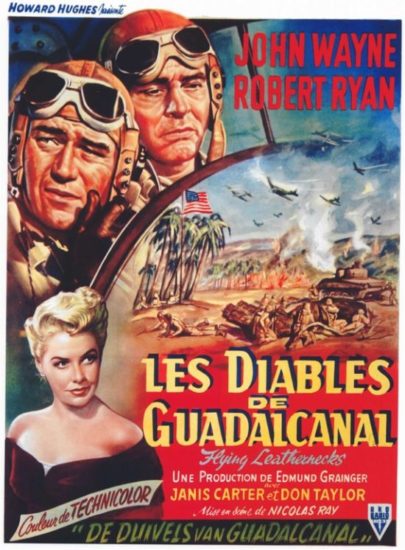 It’s directed by Nicholas Ray, who went on to direct “Rebel Without a Cause” a few years later, and pairs Wayne with Robert Ryan as two men at odds with each other on how to command a fighter squadron.
It’s directed by Nicholas Ray, who went on to direct “Rebel Without a Cause” a few years later, and pairs Wayne with Robert Ryan as two men at odds with each other on how to command a fighter squadron.
One of the downsides to the film is the overuse of stock footage in the battle sequences. By my reckoning, about 75 to 80 percent of the action in the film is comprised of shaky and out of focus shots of the real war.
At one point, as a plane spirals into the ground, you can even see a hair in the camera gate flickering across the bottom of the screen.
On the other hand, it looks as though some effort went into building a set on the backlot to then blow up using real fighter planes that have been hired for use in the movie itself.
Another disappointment is that the expected fireworks between Wayne and Ryan – Duke gets command of the squadron in favour of Ryan – doesn’t really come to life.
Just when it looks as though they’re finally going to indulge in fisticuffs another interminable bout of stock footage intervenes and the promise of a good old fashioned John Wayne punch-up never materialises.
The main thrust of the issue between the two men is down to Ryan being unable to take responsibility for sending men to their death.
It’s only when he does actually cause a pilot to die in the usual futile gesture of war that he gets respect from Duke and then eventual command of the squadron.
A bit of a lost opportunity considering the talent involved.
9. Operation Pacific (1951)
What’s not to like about “Operation Pacific”?
It’s Duke’s first WWII film of the 1950s AND it’s a submarine movie as well. I just love submarine movies.
Whilst not exactly in the same league as “Das Boot” or “Run Silent Run Deep” or even “Destination Tokyo”, the crew in this film coincidentally find themselves watching at some juncture, but it’s still a worthy entry in the submarine genre.
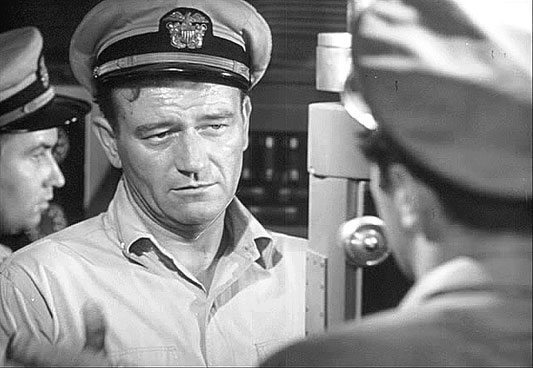 That’s mainly due to this being the product of a major studio, Warner Bros, as opposed to Republic or RKO, so the production values are elevated somewhat as opposed to previous JW WWII films.
That’s mainly due to this being the product of a major studio, Warner Bros, as opposed to Republic or RKO, so the production values are elevated somewhat as opposed to previous JW WWII films.
The film is written and directed by George Waggner who worked with Wayne previously on “The Fighting Kentuckian” back in 1949.
Strange to say after my comments on “The Flying Leathernecks”, but for some reason, the use of large amounts of stock footage in this film doesn’t appear to have the same deadening effect upon the picture as a whole as it did with Nicholas Ray’s effort.
The initial commander of the sub is Ward Bond, who pops up as ‘Pop’ Perry until he dies heroically whilst attacking a Japanese ship that has disguised itself as an unarmed vessel.
He’s then replaced by Duke, who pops up here as – well, someone called Duke Gifford. We know from the beginning that Wayne is in nice guy mode in this film as he leads a bunch of rescued kids and nuns out of the jungle.
Wayne also has one of his better co-starring leading ladies in Patricia Neal (the soon-to-be Mrs. Roald Dahl a couple of years later), playing his ex-wife in a husky voice very reminiscent of Lauran Bacall.
There’s a bit of a clunky love triangle story going on, this time between Wayne, Neal and a very young and dashing pilot played by Phil Carey.
The film reaches an exciting climax when Wayne and his crew find themselves slap in the middle of the Imperial Japanese Fleet, although the depth charge scenes lack the tension of similar scenarios in “Das Boot” for example.
On the whole, though I found this to be a fairly enjoyable JW WWII film. And of course, Wayne gets his girl back at the end.
Besides, any submarine movie that features the line ‘I could never marry a submariner. I like to sleep with the windows open’ gets a thumbs-up from me.
8. The Fighting Seabees
Based upon the real-life WWII Navy Construction Battalions, “The Fighting Seabees” revolves around a group of wartime hardhats who are restricted from taking up arms to defend themselves when the going gets tough.
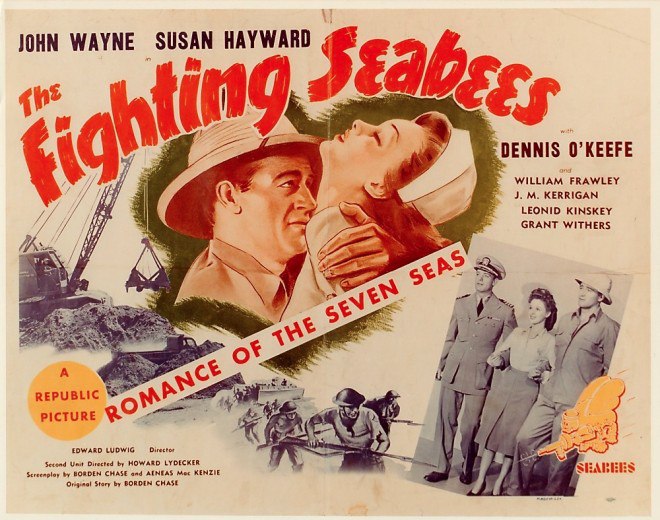 It seems they’re still classed as civilians, even though they’re building infrastructure for the army and navy in battle conditions.
It seems they’re still classed as civilians, even though they’re building infrastructure for the army and navy in battle conditions.
Step forward construction boss Wedge Donovan, played by Wayne, who fights for the rights of his workers to take on the Japanese.
It takes nearly 30 minutes before the first shot is fired in battle, the storyline, just as in “Operation Pacific”, weighed down a bit by yet another love triangle comprising Wayne, war correspondent Susan Hayward and Hayward’s boyfriend, Dennis O’Keefe, who plays a navy Lieutenant.
Hayward loves O’Keefe, then Wayne falls in love with Hayward, she falls in love with Wayne, Wayne realises he’s a heel for stealing O’Keefe’s girl, drops Hayward, then goes off and gets himself killed in the climactic battle with the Japanese.
The film is a bit of a low-budget propaganda affair with lots of back projection and use of stock footage. There’s even a guest appearance by one of the Japanese pilots from the earlier Republic / Wayne collaboration “Flying Tigers”, just to make you feel at home.
The Japanese are portrayed as merciless and callous, grinning manically as they shoot yet another character actor in the back.
Wayne engages in a suicidal mission to push a tank of boiling oil onto the attacking Japanese soldiers and flush them out into the open where they can then be humanely mown down in their hundreds on account they started the war first.
Wayne’s death scene happens very quickly – he’s shot in the chest whilst using a bulldozer to shift the oil tank – and comes as a bit of a shock, but he has to die in order for Susan Hayward to live unhappily married to Dennis O’Keefe after the war is over.
One scene that I would pay good money never to have to watch again is when, at a party sequence early on in the film, Wayne jitterbugs with a young lady who goes by the name of Twinkie Tucker – now there’s a name to conjure with.
He is not a dancer, any more than he was a singer in his 1930s Republic cowboy films. I guess it’s an example of the studio trying to get down with the kids by having Wayne engage in the terpsichorean shenanigans of the contemporary young – by my estimate, he must have been at least 36 years old when the film was made – but for me, it’s still painful to watch.
In the world of Hollywood war films, there are two constants that can never be challenged. Charlie don’t surf, and Duke don’t dance. ‘Nuff said.
7. The Green Berets (1968)
“The Green Berets” has to be the proverbial elephant in the room when it comes to Wayne’s acting career – the turkey in the room is reserved for “The Conqueror” but the less said about that the better.
I’m not going to explore the controversy that exploded in the late 1960s over this film, as I’m sure you can find enough of that elsewhere on the internet if you’re interested.
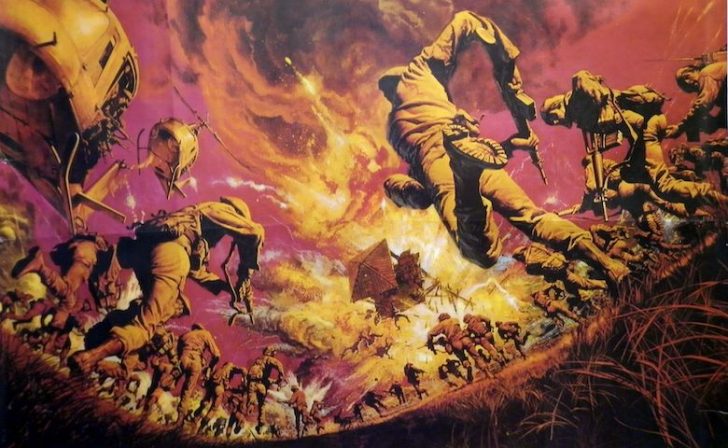 However, I think it goes without saying that whilst some people find the film a glorious tribute to the fighting American forces who gave their lives in Vietnam to halt the spread of Communism before it reached the United States.
However, I think it goes without saying that whilst some people find the film a glorious tribute to the fighting American forces who gave their lives in Vietnam to halt the spread of Communism before it reached the United States.
To others, it’s an overblown one-sided piece of right-wing propaganda that attempts to justify the promotion of a war that a lot of people in America didn’t want in the first place.
You pays your money, you makes your choice.
If one considers the film purely in terms of an action movie then the first thing I have to say is that John Wayne is just too old to be playing combat Colonel Mike Kirby, what with him being at least sixty when he appeared in the film which he co-directed with Ray Kellogg.
Duke and Aldo Ray and Bruce Cabot spend most of their time throughout the movie trying to hold their stomachs in, with Cabot failing miserably.
The film spends the first forty minutes delivering a lesson to journalists on why America is fighting the good fight in Nam.
At the same time, it also sets up each of the main characters including Jim Hutton, who is the Scrounger from “The Great Escape” by any other name, David Janssen as the cynical lily-livered left-wing journalist who asks questions that only lily-livered lefties would ask, the little orphan boy Ham Chuck, who channels his inner Short Round from “Indiana Jones and Temple of the Doom” to capture our hearts, and Luke Askew as the guy who is obviously going to buy the farm before the final reel.
By far the best sequence in the film is the set-piece of a battle that appears to be closely modelled on Wayne’s only other (official) directorial effort, “The Alamo”, with the Vietcong, laying siege to the Green Beret Nam encampment using ladders to clamber over the barbed wire.
The whole vibe of the earlier film is further reinforced with the presence of Rudy Robbins who played alongside Chuck Roberson as one of the ‘it do’ Tennesseans in “The Alamo”.
Another Alamo veteran, Patrick Wayne, pops up reprising his dad’s heroics from “The Fighting Seabees” as an engineer using a bulldozer to try and halt the advancing enemy.
After the battle in which Wayne manages to escape death twice, once by rolling clear of a downed helicopter then rolling clear of a downed observation tower, the film then takes a strange turn which I can only describe as “Mission Impossible” meets “The Dirty Dozen”, in which Wayne and his men are sent on a secret mission to kidnap a North Vietnamese General.
Needless to say, the mission is a success, although we lose Jim Hutton to a particularly gory demise when he gets perforated and stabbed up by a Cong booby trap of pointed bamboo sticks.
Cue tears from orphan Ham as he loses his new best friend, with Wayne making him feel better with the last line in the film, ‘you’re what this is all about’.
Despite the mixed critical reception for “The Green Berets”, the unassailable fact is that it took over $20m dollars at the box office making it Wayne’s biggest non-Western hit (“The Longest Day” took more but doesn’t count as Wayne only played a cameo), so someone out there must have liked it.
6. In Harm’s Way (1965)
Back in the day, they used to call films like this ‘adult movies’ and, bearing in mind director Otto Preminger’s predilection for melodramatic sensationalism, you know this isn’t going to be just another war film.
Only ten minutes in and we already have naked shenanigans on the beach, fiery death in a blazing car and, just to keep the audience on their toes, the Japanese attack on Pearl Harbour.
 The mayhem on the ground appears to come from invisible planes in the sky – similar to the destruction of the train depot sequence in John Frankenheimer’s “The Train” which was released the year before – so budget-wise we’re not talking “Tora! Tora! Tora!” here.
The mayhem on the ground appears to come from invisible planes in the sky – similar to the destruction of the train depot sequence in John Frankenheimer’s “The Train” which was released the year before – so budget-wise we’re not talking “Tora! Tora! Tora!” here.
Wayne turns up as Captain Rockwell Torrey, his boat torpedoed whilst in pursuit of the Japanese fleet and ending up demoted to a desk job for not following procedure. Before you know it he’s hooked up with Patricia Neal again, returning as a slightly older version of the same nurse she played in “Operation Pacific”.
I’m not going to go through the whole story here but during the course of this nearly three-hour film, Preminger throws in, along with the small matter of fighting a war, the rape of a young nurse, suicide, adultery, betrayal and the discovery by Wayne that his estranged son, played by Brandon DeWilde, the kid from “Shane”, has enlisted and serves nearby on a PT boat.
Duke’s performance is a modicum of restraint compared to some of the more overblown acting of Kirk Douglas and Burgess Meredith in the film, and you can see, and sense, that age is really starting to catch up with him.
There are a few moments when he does his ‘John Wayne’ bit as his cruiser is almost sunk beneath him but there’s a real attempt on the part of the actor to play someone who isn’t just a man of action.
‘Rock’ Torrey is a flawed individual who is unable to reconcile with his estranged son and is also subject to the dangers of war like anybody else, eventually losing his leg during the climactic sea battle.
This time around it’s Kirk’s turn to take on a suicide mission, flying to his doom whilst tracking down the location of the Japanese fleet, a task he has taken on out of guilt after the suicide of a nurse he raped who also happened to engaged to Wayne’s son – see, I told you this was an adult movie.
On top of that poor old Brandon DeWilde cops it at the end during a torpedo attack on a Japanese battleship, whilst Wayne is left standing at the end, albeit on one leg.
I have to say that “In Harm’s Way” is a rather underrated film in John Wayne’s CV, although it is badly let down by the complete reliance on models and studio water tanks for the face-off with the Japanese fleet at the end.
It just goes to show what Wayne could do outside of the Western genre when given the chance to work with a top-notch Hollywood director and a decent script. The soundtrack by Jerry Goldsmith isn’t too bad either.
so moving into the top 5 best John Wayne movies…
5. The Longest Day (1962)
I admit to this being one of my all-time favourite WWII films that just happens to have John Wayne in it.
It’s not strictly a JW leading role film as Wayne features alongside a plethora of other Hollywood stalwarts such as Robert Mitchum, Henry Fonda, Robert Ryan and Rod Steiger to name but a few.
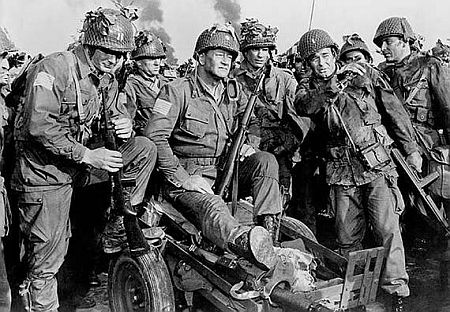 You’ll also spot a few British actors in the cast to give the impression the film is a genuine depiction of a shared allied experience – Richard Todd, Kenneth More, Richard Burton, et al – but make no mistake, this is a Hollywood production through and through.
You’ll also spot a few British actors in the cast to give the impression the film is a genuine depiction of a shared allied experience – Richard Todd, Kenneth More, Richard Burton, et al – but make no mistake, this is a Hollywood production through and through.
Although he only has about 20 minutes of screen time in a film that runs for 2 hours and 40 minutes our boy makes the most of his portrayal of the real life Lieutenant Colonel Benjamin H. Vandervoort, even if Wayne was playing at the age of 55 someone who was actually only 27 in 1944.
If I had to pick Duke’s best moment in “The Longest Day” it would be the speech he makes to his troops just before the D-Day landings take place, telling his men that ‘Your assignment tonight is strategic.
You can’t give the enemy a break.
Send ‘em to hell…. That is all’.
I mean, come on. You have to love this guy, right?
As shown in the film, Vandervoort, who was the Commanding Officer of his battalion when he participated in the D-Day operation, did actually break his ankle when parachuting into Normandy.
He apparently ordered his boot to be tightly laced whilst participating in pushing back a counterattack by German forces before then going on to help defend the French village of Saint-Mere-Eglise.
Even if his appearance is just an extended cameo in which Wayne spends a lot of his time being wheeled around on a makeshift stretcher his performance is still head and shoulders above the rest of the other actors in the film – and this time he wins the war without firing a shot. And with a broken ankle.
Thanks be to our maker that he was on our side, that’s all I can say.
Trivia note: Producer Daryl F. Zanuck heavily criticized Wayne when it was announced JW would be producing, directing and acting in “The Alamo”.
A few years later a contrite Darryl had to stump up two-hundred and fifty-thousand dollars in order to entice Wayne to sign up for “The Longest Day”.
By my reckoning that’s around twenty-thousand eight-hundred and thirty-three dollars and thirty-three cents per minute. The film took over $39 million at the box office so Zanuck still got himself a bargain there.
4. The Flying Tigers (1942)
Released in 1942 by Republic Studios, to which Wayne was under contract at the time, this is a really great action film with Wayne playing Jim Gordon, the commander of a volunteer group of American fliers stationed in China just before America enters the war in order to protect the local population from the dastardly Japanese air force.
 The film has echoes of an earlier film “Only Angels Have Wings”. Which was directed by Howard Hawks and released in 1938, which in itself was a remake of an even earlier John Ford film made in 1932 called “Air Mail”.
The film has echoes of an earlier film “Only Angels Have Wings”. Which was directed by Howard Hawks and released in 1938, which in itself was a remake of an even earlier John Ford film made in 1932 called “Air Mail”.
One of the fliers hired by Wayne has a dodgy background, just as Richard Barthelmess had in the Hawks film. There’s also a scene in “Flying Tigers” that duplicate one from “Only Angels Have Wings” when the crew on the ground are surrounded in fog as a flier struggles to land his plane safely.
Also of note is that one of the stalwarts of the John Ford stock company, Anna Lee, plays Wayne’s love interest, and co-star John Carroll refers to Wayne as Pappy, which of course was Wayne’s affectionate name for John Ford. Here endeth the Ford / Hawks comparisons. We’ve written more on JW and Ford.
Although most of the flying sequences are a combination of stock footage and model work, the action scenes more than make up for the clichéd love triangle of Wayne, Carroll and Lee that plays out on the ground.
What might be of interest to a contemporary audience is that Wayne and his compatriots are fighting on behalf of the Chinese leader, Chiang Kai-Shek, who was not exactly known for his enthusiasm towards western democracy.
At least he wasn’t a Commie so I guess Wayne figured he was fighting for the right side. There’s also not much here to keep the politically correct brigade of today happy when it comes to the portrayal of the Japanese, the enemy shown murderously bombing hospitals and shooting one hapless American pilot as he attempts to parachute to safety.
Wayne is obviously the star of the film, and he finally comes into his own once the volunteers hear that the Japanese have attacked Pearl Harbour, making their war in China official.
Our man immediately puts himself forward for a suicide mission, his death-wish scuppered when John Carroll tricks Wayne into parachuting out of a plane full of explosives that Carroll then flies into a Japanese troop train.
I really like this film. It’s unadulterated propaganda but highly entertaining all the same so it gets a resounding thumbs-up as far as I’m concerned.
3. Back to Bataan (1945)
A change of studio for Wayne as this was produced by RKO, who look as though they have a bit more money to spend on the script.
The film, released in May 1945, just a few weeks after VE Day, is directed by Edward Dmytryk, who a couple of years later fell victim to the anti-Communist witch hunts in Hollywood and ended up in jail for contempt.
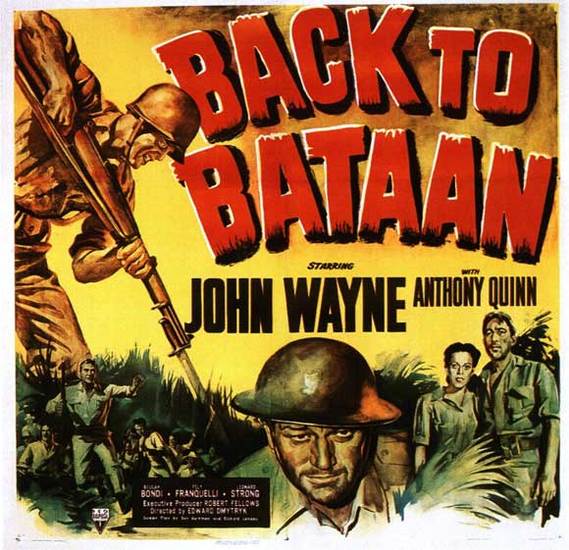 According to some sources Wayne and Dmytryk clashed towards the end of production over their differing political leanings. Despite the conflict behind the camera, however, the end result is the best WWII film Wayne appeared in up to that point.
According to some sources Wayne and Dmytryk clashed towards the end of production over their differing political leanings. Despite the conflict behind the camera, however, the end result is the best WWII film Wayne appeared in up to that point.
Wayne is Colonel Joe Madden, tasked with rallying the resistance forces in the Philippines against the invading Japanese.
The film begins with a march past the camera of some of the real-life American POWs who were held in captivity at the time the film was set in 1942, the idea being I guess to demonstrate the veracity of what follows.
One of the main differences between this film and the previous two WWII movies Wayne appeared in for Republic is that he has no love interest to distract him from the task in the hand.
That falls to his co-star, Anthony Quinn, here playing Zorba the Filipino Resistance Hero in much the same way as he eked out a career as Zorba the Circus Performer (“La Strada”), Zorba the Arab (“Lawrence of Arabia”) and Zorba the Greek in, well… “Zorba the Greek”.
This is quite a brutal film for its time, with summary executions of American POWs on a Japanese death march, the hanging of a teacher from a flagpole, the torture of a young Filipino boy, and Japanese soldiers being knifed and chopped to death.
The Japanese themselves are now portrayed as real people as opposed to the sadistic nameless killers with no back story from “The Flying Tigers” and “The Fighting Seabees”. They’re still sadistic killers of course but they’re shown to have very nice table manners, so I guess that’s a start.
The film is more of a tribute to the Filipino resistance than it is to the American’s who fought in the Philippines, possibly because the war in the Philippines is maybe viewed in the same way as the British view Dunkirk: an honourable defeat, but a defeat nonetheless.
Wayne still takes centre stage however, and in this one he gives good war, throwing himself with gusto into the action and machine-gunning and blowing up the enemy with the best of them.
At one point he is blasted into the air by the force of a hand grenade, a stunt he obviously performed himself, proving how much he was prepared to suffer for his art.
One scene worth noting is when Wayne tells a young Filipino boy that ‘you’re the guy we’re fighting this war for”. This predates by 23 years the last line from “The Green Berets”, in which he tells a young Vietnamese boy of similar age that ‘you’re what this is all about”.
Uncanny, or what?
This is one Wayne WWII film I’d gladly watch again. If you get the opportunity check out a film called “Bataan”, directed by Tay Garnett and released a couple of years before in 1943.
That film deals with the events prior to “Back to Bataan” and together they make a great double bill.
2. They Were Expendable (1946)
Despite Wayne being cast second in the bill to Robert Montgomery, this is the first real classic WWII film of his career.
It doesn’t hurt of course that it was directed by John Ford and the film, to my mind, is a small yet underrated masterpiece in the director’s body of work.
 The film was released just after the end of the war by MGM in early 1946 and tells the story, based on fact, of two navy Lieutenants, John Brickley, played by Montgomery, and Rusty Ryan (Wayne) who are instrumental in using PT boats to attack the Japanese navy in defence of the Philippines.
The film was released just after the end of the war by MGM in early 1946 and tells the story, based on fact, of two navy Lieutenants, John Brickley, played by Montgomery, and Rusty Ryan (Wayne) who are instrumental in using PT boats to attack the Japanese navy in defence of the Philippines.
The film itself, like Wayne’s performance, is a subdued and somewhat melancholy affair, bearing in mind, as the screenwriter Lem Dobbs points out in a documentary on Ford, that the title suggests most of the characters are dead by the time their story is told.
Montgomery, unlike Wayne, had actually served during the war in the navy and commanded a PT boat in the Pacific.
On top of that Ford had also seen action with his photographic unit at Midway, in which he was mildly wounded by some shrapnel, and had also witnessed the D-Day landings.
Ford apparently rode Wayne mercilessly for not having voluntarily enlisted himself, moving Montgomery to intervene on Wayne’s behalf and upbraiding Ford accordingly, which I think goes some way to explaining Wayne’s low-key performance in the film.
Ford isn’t generally known for his action sequences, being more interested in character and mood.
The battle between the PT boats and the Japanese fleet, however, is genuinely exciting and extremely authentic, no doubt helped by Ford and Montgomery having witnessed the real thing during the war itself.
Wayne gets to survive this one, both he and Montgomery having to leave their men behind to help organise other PT boat missions on behalf of the navy.
Inevitably, this being a WWII movie, the film ends with a rendition of “Glory glory hallelujah”, but the triumphalism is weighed down by the fact that the men they leave behind will most probably not make it back to their families in America.
The script was written by Frank Wead, or ‘Spig’ as he was known, a real-life character that Wayne went on to portray in Ford’s “The Wings of Eagles”, released in 1957.
And the number one spot in Top Ten John War Movies goes too…
Sands of Iwo Jima (1949)
With this film, released in 1949, Republic finally delivers the goods when it comes to Wayne at war.
Directed by Allan Dwan who, like Ford, had started his career in the silent era, the film depicts the savagery of the no-holds-barred fighting at Iwo Jima.
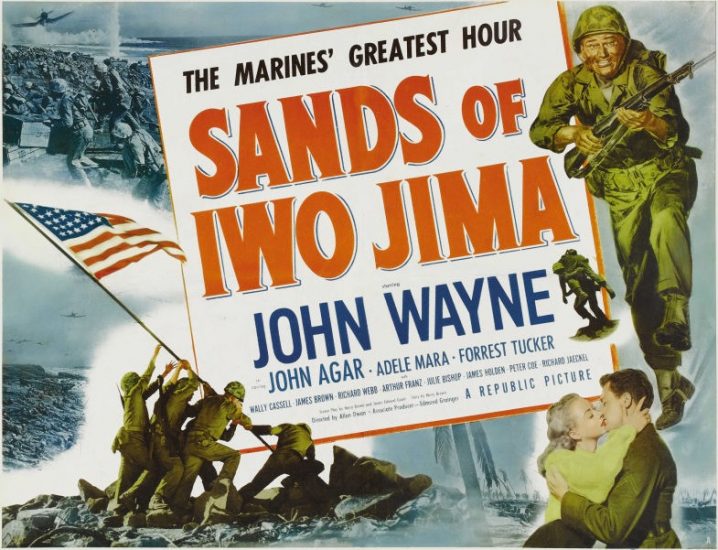 Nominated for his first Academy Award, Wayne’s performance is more complex than usual, something he had started to hint at in “Red River” the year before and which reached its height in “The Searchers” a few years later.
Nominated for his first Academy Award, Wayne’s performance is more complex than usual, something he had started to hint at in “Red River” the year before and which reached its height in “The Searchers” a few years later.
He plays Sergeant Stryker, a veteran of Guadalcanal, who is put in charge of getting his marines in shape for battle.
When you read about JW or watch any of his interviews you get the feeling he was used to having his way and telling people what to do all the time so I think this is a perfect role for Wayne, and probably why he was so good in this film.
The Japanese, now that the war had been over for about 4 years, are now referenced a bit more respectfully.
This time around they’re all Nips or ‘little lemon coloured characters’. They’re reduced once more, however, to non-characters, the enemy the audience doesn’t get to know apart from watching them bayonet and kill their way through the film.
Also, even if I hadn’t picked up on it in the credits, I would have guessed James Edward Grant had something to do with the script.
Wayne utters the words ‘I’m going to tell you something’, in exactly the same way he addresses Linda Crystal in “The Alamo”, which of course Grant also wrote the script for.
Harking back to “The Fighting Seabees”, there’s a small dancing sequence in which Wayne shows a recruit with two left feet how to march in the correct rhythm. It illustrates yet again that he really ought not to do this in front of a paying audience.
Although it’s nearly half an hour before the action hits the screen it’s well worth the wait.
The battle sequences, despite being interspersed with stock footage of what appears to be the real fight for Iwo Jima, are quite impressive, and more realistic than previous Wayne WWII films.
I think it could have done without the Hollywood practise of giving someone a final word just before they die, one character who has just been shot exclaiming ‘I’ll get a good night’s sleep tonight’ before crumpling to the ground.
On the other hand, it adds to the genuine shock of Wayne’s own sudden death scene because he doesn’t get the chance to say anything at all.
One moment he’s telling everyone he feels good, the next thing he’s being shot in the back by one of those nasty Nips and dying instantly.
Stryker’s death scene is followed by a final sequence in which the flag is finally raised on Iwo Jima, a genuinely moving and fitting tribute to the real soldiers who died there.
One of the original flag-raisers, Ira Hayes, also appears in this scene. “Sands of Iwo Jima” is the best of all of the war films Wayne appeared in and, as already mentioned, the Academy thought so too by handing him his first Oscar nomination as Best Actor in the process.
In the end, he lost out to Broderick Crawford but in our humble opinion, the guy was well and truly robbed.

So, John’s first Academy Award nomination for Best Actor in Sands of Iwo Jima couldn’t make your Top Five WarFilms List?
Don’t worry Don. This is actually the first of a two-part article on my Top Ten John Wayne war movies so apologies for the confusion. I think you’ll be pleasantly surprised once you see the second article.